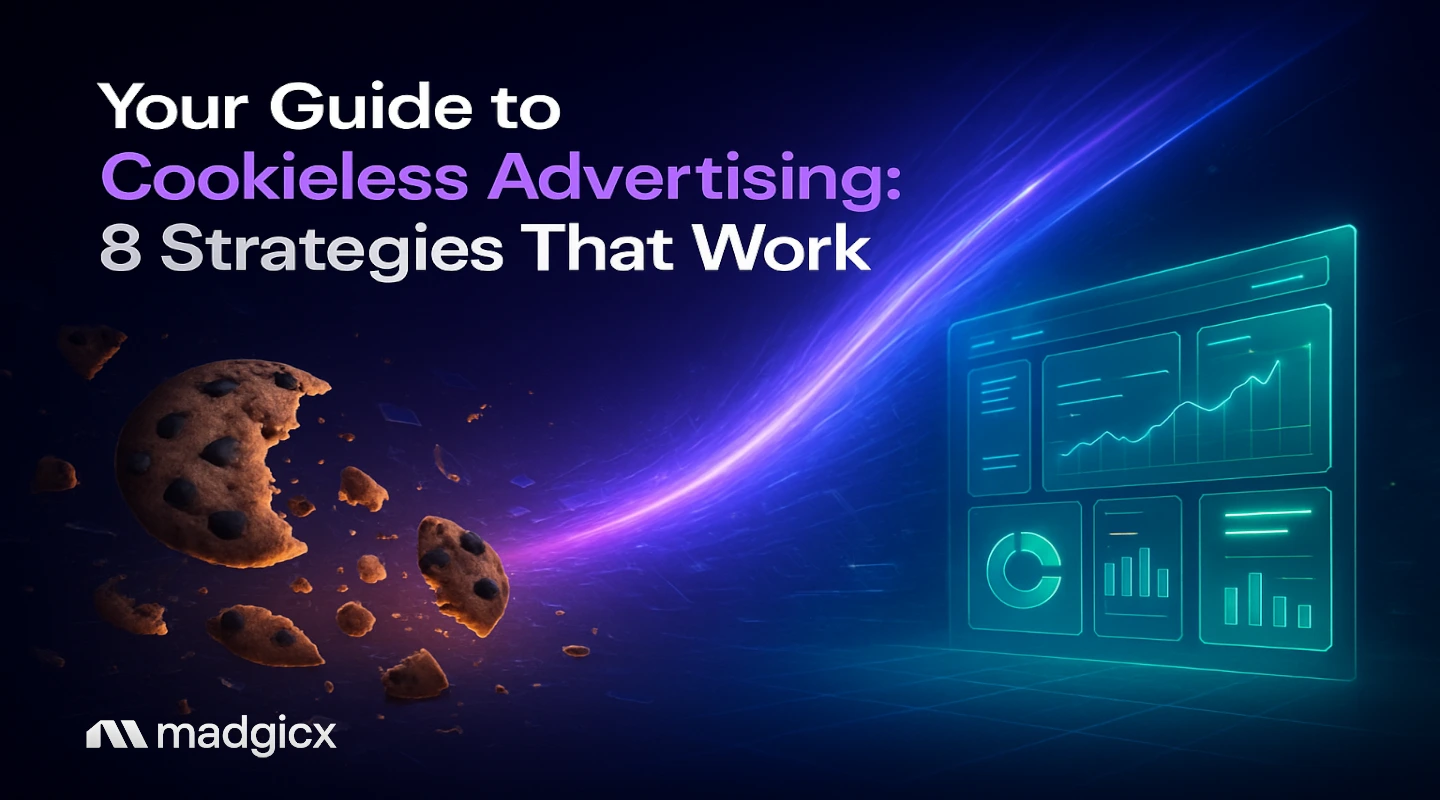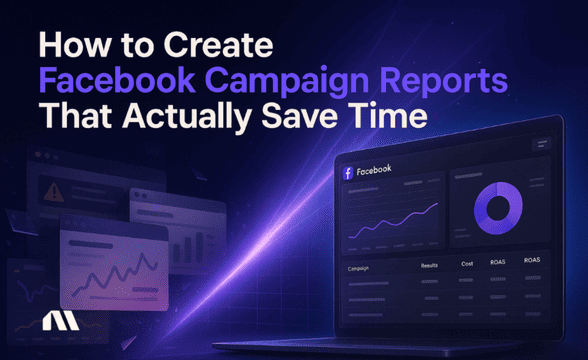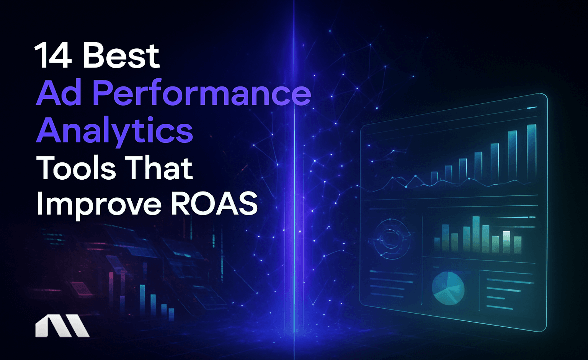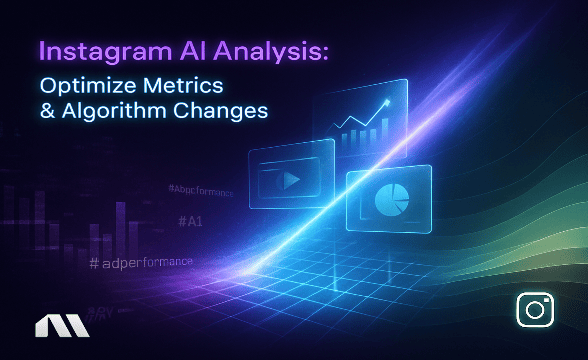Master cookieless advertising with 8 proven strategies for 2025. Learn AI attribution, first-party data tactics, and privacy-compliant targeting that boost ROI.
Picture this: You're checking your campaign dashboard on Monday morning, and your attribution data looks like Swiss cheese. Sound familiar?
Here's a reality check that might sting a bit—75% of marketers heavily rely on third-party cookies to track user behavior, but over 40% of web traffic now comes from browsers that block these cookies by default.
We're watching performance marketers scramble as their attribution models crumble faster than a stale cookie (pun intended). CPAs are climbing, targeting precision is dropping, and everyone's wondering how to maintain campaign effectiveness when the tracking foundation they've built their careers on is disappearing.
But here's what separates the smart marketers from the panicked ones: they're not just surviving this cookieless transition—they're using it as a competitive advantage. While competitors cling to outdated tracking methods, forward-thinking performance marketers are implementing AI-powered attribution systems and first-party data strategies that can be more effective than traditional cookie-dependent approaches.
Cookieless advertising refers to marketing strategies that operate without relying on third-party cookies, instead using first-party data, contextual targeting, and privacy-compliant technologies to reach and engage audiences while respecting user privacy. The shift isn't just about compliance—it's about building more sustainable, accurate, and customer-centric advertising systems.
What You'll Master in This Guide
By the time you finish reading, you'll have a complete roadmap for thriving in the cookieless era. Here's exactly what we're covering:
- 8 proven cookieless advertising strategies with step-by-step implementation frameworks
- AI attribution modeling techniques that replace cookie-based tracking more effectively
- First-party data collection systems that actually scale without overwhelming your team
- Contextual targeting methods that maintain precision while respecting user privacy
- Cost-benefit analysis framework for evaluating and prioritizing cookieless solutions
Bonus: You'll get a 90-day implementation timeline that prioritizes the highest-impact strategies first.
The Cookieless Reality: What Performance Marketers Need to Know
Let's start with the numbers that should keep every performance marketer awake at night. According to recent industry research, 82% of high-growth companies are shifting to first-party data strategies, but here's the kicker—most lack proper implementation frameworks.
The impact is already hitting bottom lines hard. Publishers are expecting a 43% decline in ad revenue when third-party cookies are blocked, while programmatic advertising has experienced a 52% decline in revenue for top publishers operating in cookieless environments.
The Attribution Crisis
Traditional attribution models are breaking down because they rely on persistent identifiers that follow users across websites. When Safari's Intelligent Tracking Prevention and Chrome's Privacy Sandbox eliminate these identifiers, marketers lose the ability to connect touchpoints accurately.
This creates three critical problems:
- Underattribution of upper-funnel activities leading to budget misallocation
- Overattribution to last-click channels like branded search
- Inability to optimize for true customer lifetime value
But here's where it gets interesting—smart marketers are discovering that AI-powered attribution models can provide more accurate insights than cookie-based tracking in many scenarios. Instead of relying on deterministic tracking that misses cross-device behavior and private browsing sessions, machine learning models can identify patterns and predict user behavior more effectively.
Pro Tip: Start implementing AI attribution alongside your existing models now. This parallel approach lets you validate accuracy while building confidence in cookieless measurement before you're forced to make the switch.
Strategy #1: First-Party Data Collection That Scales
Your first-party data is about to become your most valuable asset. 78% of marketers believe their data will become more valuable in a cookieless world, but collecting it effectively requires a systematic approach.
Progressive Profiling Framework
Instead of hitting visitors with lengthy forms that kill conversion rates, implement progressive profiling that gradually builds customer profiles over time:
- Initial Contact: Collect only essential information (email, basic preferences)
- Engagement Milestones: Request additional data at natural interaction points
- Value Exchange: Offer personalized content, discounts, or exclusive access in return
- Behavioral Enrichment: Use on-site behavior to infer preferences and interests
High-Converting Data Collection Tactics
- Interactive Content: Quizzes, assessments, and calculators that provide value while collecting preferences
- Preference Centers: Let customers control their data sharing and communication preferences
- Loyalty Programs: Incentivize data sharing through points, rewards, and exclusive benefits
- Content Gating: Offer premium content in exchange for detailed profile information
Technical Implementation
Set up your data collection infrastructure to capture and unify customer information across all touchpoints. This includes:
- Customer Data Platform (CDP) integration
- Cross-device identity resolution
- Real-time data activation for personalization
- Privacy-compliant data storage and processing
Madgicx automatically enriches your first-party data with AI-powered Meta ad insights, helping you understand customer behavior patterns and optimize targeting without relying on third-party cookies. Our platform identifies high-value customer segments and automatically adjusts campaign targeting based on first-party data signals.
Pro Tip: Implement a "data value ladder" where customers receive increasingly valuable benefits as they share more information. Start with basic email signup rewards, then offer premium content for profile completion, and exclusive access for detailed preference sharing.
Strategy #2: AI-Powered Attribution Modeling
This is where the magic happens. While traditional attribution crumbles without cookies, AI-powered models can improve performance with diverse data sources.
From Deterministic to Probabilistic Attribution
Traditional attribution relies on deterministic tracking—following specific users through exact touchpoints. AI attribution uses probabilistic modeling to understand customer journeys even when individual tracking isn't possible.
Here's how it works:
- Pattern Recognition: Machine learning identifies common customer journey patterns across your entire customer base
- Statistical Modeling: AI calculates the probability that specific touchpoints contributed to conversions
- Continuous Learning: Models improve accuracy as they process more conversion data
- Cross-Device Insights: AI connects behaviors across devices using statistical correlation rather than persistent identifiers
Implementation Steps for AI Attribution
- Data Integration: Connect all customer touchpoints (website, email, social, offline)
- Conversion Definition: Clearly define what constitutes a conversion and assign values
- Model Training: Feed historical data to train your AI attribution model
- Testing Phase: Run AI attribution alongside existing models to validate accuracy
- Optimization: Use AI insights to reallocate budget and optimize campaigns
Advanced AI Attribution Techniques
- Incrementality Testing: AI models can predict what would have happened without specific touchpoints
- Customer Lifetime Value Attribution: Connect short-term conversions to long-term customer value
- Cross-Platform Unification: Understand how different advertising platforms work together
- Real-Time Optimization: Automatically adjust campaigns based on attribution insights
Madgicx specializes in AI-powered attribution modeling designed for cookieless environments. Our platform provides comprehensive AI optimization capabilities, with 24/7 automated attribution analysis that adapts to cookieless environments. The system continuously learns from your campaign data to improve attribution accuracy and automatically optimizes budget allocation across channels.
For deeper insights into how AI transforms attribution, check out our comprehensive guide on multi-touch attribution AI strategies.
Strategy #3: Contextual Targeting 2.0
Contextual targeting isn't just about placing ads next to relevant content anymore—it's evolved into a sophisticated AI-powered approach that understands context, sentiment, and user intent without tracking individuals.
Semantic Analysis and Content Understanding
Modern contextual targeting uses natural language processing to understand:
- Content Themes: Beyond keywords to understand actual topics and themes
- Emotional Context: Whether content is positive, negative, or neutral
- User Intent Signals: What actions users are likely to take based on content consumption
- Brand Safety: Automatically avoiding content that conflicts with brand values
Advanced Contextual Strategies
- Dynamic Creative Optimization: Automatically adjust ad creative based on page content
- Moment-Based Targeting: Target users based on real-time events and trending topics
- Cohort Contextual Targeting: Target groups of users consuming similar content types
- Cross-Platform Context Mapping: Understand how context differs across platforms and devices
Technical Implementation
- API Integration: Connect with contextual targeting platforms and DSPs
- Content Categorization: Set up automated content classification systems
- Performance Monitoring: Track contextual performance metrics and optimize accordingly
- Creative Versioning: Develop multiple ad variations for different contextual environments
The key advantage of contextual targeting in a cookieless world is that it's inherently privacy-compliant while still enabling precise targeting based on immediate user context and intent.
Strategy #4: Privacy Sandbox and Universal ID Solutions
Google's Privacy Sandbox represents the future of privacy-compliant advertising technology. Understanding and implementing these solutions early gives you a significant competitive advantage.
Privacy Sandbox APIs Implementation
- Topics API: Replace third-party cookies with interest-based targeting
- FLEDGE: Enable remarketing without cross-site tracking
- Attribution Reporting API: Measure conversions while preserving privacy
- Trust Tokens: Combat fraud without tracking individual users
Universal ID Solutions
While Privacy Sandbox develops, several universal ID solutions provide immediate alternatives:
- Unified ID 2.0: Industry-standard identifier based on hashed email addresses
- LiveRamp IdentityLink: Cross-device identity resolution using first-party data
- ID5: Privacy-compliant universal identifier for programmatic advertising
Implementation Roadmap
- Assessment Phase: Evaluate which solutions align with your data strategy
- Technical Setup: Implement necessary APIs and tracking codes
- Testing Environment: Run parallel campaigns to compare performance
- Gradual Migration: Slowly shift budget from cookie-based to privacy-compliant solutions
- Performance Optimization: Continuously optimize based on new data signals
Pro Tip: Don't wait for full Privacy Sandbox rollout. Start testing available APIs now in sandbox environments to understand their impact on your campaigns and build technical expertise before widespread adoption.
Strategy #5: Data Clean Rooms and Secure Collaboration
Data clean rooms enable secure collaboration between advertisers, publishers, and platforms without sharing raw customer data. This technology is becoming essential for maintaining targeting precision in a privacy-first world.
How Data Clean Rooms Work
- Secure Environment: Data stays within protected environments controlled by neutral third parties
- Aggregated Insights: Analysis produces statistical insights without exposing individual records
- Privacy Preservation: Advanced encryption ensures individual privacy while enabling useful analysis
- Cross-Platform Collaboration: Multiple parties can contribute data for richer insights
Implementation Strategy
- Partner Selection: Choose data clean room providers that integrate with your existing tech stack
- Data Preparation: Clean and standardize your first-party data for clean room analysis
- Use Case Definition: Clearly define what insights you want to gain from collaborative analysis
- Performance Measurement: Establish metrics to evaluate clean room effectiveness
Practical Applications
- Audience Overlap Analysis: Understand shared customers with partners without exposing individual data
- Attribution Modeling: Combine data from multiple touchpoints for more accurate attribution
- Lookalike Modeling: Create better lookalike audiences using expanded data sets
- Campaign Optimization: Optimize campaigns based on insights from multiple data sources
Strategy #6: Enhanced Conversion Tracking
Server-side tracking and conversion APIs provide more reliable measurement than client-side tracking, especially in cookieless environments where browser restrictions limit traditional tracking methods.
Server-Side Tracking Implementation
- Conversion API Setup: Implement Facebook's Conversions API, Google's Enhanced Conversions, and similar solutions
- Data Layer Configuration: Ensure your website sends complete conversion data to your servers
- Privacy Compliance: Implement proper consent management and data handling procedures
- Quality Assurance: Validate that server-side data matches client-side measurements
Advanced Tracking Techniques
- Offline Conversion Tracking: Connect online advertising to offline sales and actions
- Cross-Device Measurement: Use first-party data to understand cross-device customer journeys
- Customer Lifetime Value Tracking: Measure long-term value, not just immediate conversions
- Incremental Conversion Measurement: Understand which conversions are truly incremental
Technical Requirements
- Robust Data Infrastructure: Ensure your servers can handle increased data processing
- Real-Time Processing: Implement systems that can process and send conversion data quickly
- Error Handling: Build redundancy to prevent data loss during transmission
- Performance Monitoring: Track data quality and delivery success rates
For comprehensive guidance on implementing enhanced tracking, explore our detailed analysis of Meta ads revenue attribution strategies.
Strategy #7: Cohort-Based and Lookalike Modeling
Statistical modeling enables audience targeting without tracking individual users. By analyzing groups of users with similar characteristics, you can maintain targeting precision while respecting privacy.
Cohort Analysis Framework
- Behavioral Cohorts: Group users based on similar on-site behaviors and engagement patterns
- Temporal Cohorts: Analyze users who converted during similar time periods
- Value-Based Cohorts: Segment customers by lifetime value and purchase behavior
- Channel Cohorts: Understand how different acquisition channels produce different customer types
Advanced Lookalike Modeling
- Multi-Dimensional Modeling: Use multiple data points to create more accurate lookalike audiences
- Dynamic Lookalikes: Automatically update lookalike audiences based on new conversion data
- Negative Lookalikes: Identify and exclude audiences similar to low-value customers
- Cross-Platform Lookalikes: Create consistent audiences across different advertising platforms
Implementation Best Practices
- Data Quality: Ensure your seed audiences are large enough and representative
- Regular Updates: Refresh lookalike models regularly to maintain accuracy
- Performance Testing: A/B test different lookalike configurations to optimize performance
- Privacy Compliance: Ensure lookalike modeling complies with privacy regulations
Strategy #8: Cross-Platform Optimization Without Cookies
Managing campaigns across multiple platforms becomes more complex without unified tracking, but AI-powered optimization can actually improve cross-platform performance.
Unified Campaign Management
- Centralized Data Collection: Aggregate performance data from all platforms in a single dashboard
- Cross-Platform Attribution: Use AI to understand how different platforms work together
- Budget Optimization: Automatically allocate budget based on cross-platform performance
- Creative Optimization: Test and optimize creative across platforms simultaneously
Platform-Specific Adaptations
- Facebook/Instagram: Leverage Conversions API and first-party data for targeting
- Google Ads: Implement Enhanced Conversions and Customer Match
- TikTok: Use TikTok Events API and first-party data integration
- LinkedIn: Use Conversions API and company data for B2B targeting
Advanced Cross-Platform Strategies
- Sequential Messaging: Coordinate messaging across platforms for cohesive customer experiences
- Platform Specialization: Optimize each platform for its unique strengths and audience behaviors
- Cross-Platform Retargeting: Use first-party data to retarget across multiple platforms
- Unified Reporting: Create comprehensive reports that show true cross-platform ROI
Madgicx supports cross-platform optimization, providing AI-powered insights that help you understand how your campaigns perform across Facebook, Google, TikTok, and other platforms. Our automation tools optimize budget allocation and creative performance across your entire advertising ecosystem.
Pro Tip: Create a "platform hierarchy" based on your customer journey. Use awareness platforms (like TikTok) for discovery, consideration platforms (like Facebook) for nurturing, and conversion platforms (like Google) for capturing intent. This strategic approach maximizes each platform's strengths.
Tools and Resources for Cookieless Success
Essential Platforms and Solutions
- Madgicx: AI-powered attribution and optimization platform designed for cookieless environments
- Google Analytics 4: Privacy-first analytics with machine learning insights
- Customer Data Platforms: Segment, Salesforce CDP, or Adobe Experience Platform
- Consent Management: OneTrust, Cookiebot, or similar privacy compliance tools
Technical Implementation Tools
- Tag Management: Google Tag Manager with server-side tagging capabilities
- Data Clean Rooms: Google Ads Data Hub, Amazon DSP, or LiveRamp Safe Haven
- Identity Solutions: LiveRamp IdentityLink, Unified ID 2.0, or ID5
- Attribution Platforms: Madgicx AI Marketer, Triple Whale, or Northbeam
Measurement and Analytics
For advanced analytics capabilities, consider implementing comprehensive Meta analytics solutions that work effectively in cookieless environments.
Future Outlook and Implementation Roadmap
90-Day Implementation Timeline
Days 1-30: Foundation Building
- Audit current tracking and attribution setup
- Implement enhanced conversion tracking (Conversions API, Enhanced Conversions)
- Begin first-party data collection optimization
- Set up basic AI attribution modeling
Days 31-60: Advanced Implementation
- Deploy contextual targeting campaigns
- Implement Privacy Sandbox APIs (where available)
- Set up data clean room collaborations
- Launch cohort-based audience strategies
Days 61-90: Optimization and Scaling
- Optimize AI attribution models based on performance data
- Scale successful cookieless strategies across all campaigns
- Implement advanced cross-platform optimization
- Develop long-term cookieless advertising strategy
Success Metrics to Track
- Attribution Accuracy: Compare AI attribution insights to traditional models
- Campaign Performance: Monitor CPAs, ROAS, and conversion rates
- Data Quality: Track first-party data collection and enrichment rates
- Privacy Compliance: Ensure all strategies meet privacy regulations
Future Developments to Monitor
The cookieless landscape continues evolving rapidly. Stay informed about:
- Privacy Sandbox Updates: Google's ongoing API developments and timeline changes
- Browser Policy Changes: Safari, Firefox, and Chrome privacy feature updates
- Regulation Changes: GDPR updates, state privacy laws, and industry standards
- Technology Innovations: New attribution models, identity solutions, and measurement tools
Frequently Asked Questions
How accurate is attribution without cookies?
AI-powered attribution models have shown potential to be more accurate than cookie-based tracking in many cases. While cookies miss cross-device behavior, private browsing sessions, and users who delete cookies, AI models use statistical analysis to identify patterns across your entire customer base. Studies suggest that AI attribution models can improve accuracy compared to traditional last-click attribution in many scenarios.
What's the cost impact of switching to cookieless advertising?
Initial implementation requires investment in new tools and training, but most advertisers see improved ROI within 3-6 months. The key is that cookieless strategies often improve targeting efficiency and reduce wasted ad spend. First-party data typically converts better than third-party data, helping to offset any initial setup costs.
How do I maintain personalization without third-party data?
Focus on first-party data collection and AI-powered insights. Progressive profiling, behavioral analysis, and contextual targeting can provide highly personalized experiences. Many advertisers find that first-party data enables better personalization because it's more accurate and comprehensive than third-party data.
Which cookieless strategies deliver the fastest ROI?
Enhanced conversion tracking and AI attribution typically show immediate improvements in data accuracy and campaign optimization. First-party data collection and contextual targeting usually show results within 30-60 days. The key is implementing strategies in the right order—start with measurement and attribution, then move to targeting and optimization.
How does AI attribution compare to traditional tracking?
AI attribution provides several advantages over traditional cookie-based tracking:
- Cross-device insights without requiring persistent identifiers
- Privacy compliance by design
- Improved accuracy potential through statistical modeling
- Future-proof approach that adapts to changing privacy landscape
- Deeper insights into customer journey complexity
For more detailed information about AI attribution capabilities, explore our guide on AI marketing insights.
Your Next Steps in Cookieless Advertising
The cookieless future isn't coming—it's here. While many advertisers are still scrambling to adapt, you now have a complete roadmap for not just surviving but thriving in this new environment.
Your Immediate Action Plan:
- Start with AI attribution: Implement AI-powered attribution modeling to understand your true customer journeys
- Audit your first-party data: Identify gaps in your data collection and implement progressive profiling
- Test contextual targeting: Launch small-scale contextual campaigns to understand performance potential
- Implement enhanced tracking: Set up Conversions API and server-side tracking for more reliable measurement
The eight strategies we've covered aren't just theoretical concepts—they're practical frameworks that leading performance marketers are using right now to maintain and improve their advertising effectiveness. The key is starting with the foundation (AI attribution and first-party data) and building from there.
Remember: The advertisers who adapt quickly to cookieless advertising will have a significant competitive advantage over those who wait. While competitors struggle with broken attribution and declining performance, you'll be operating with more accurate data, better targeting, and improved ROI.
The technology exists today to make cookieless advertising more effective than cookie-based advertising in many scenarios. The question isn't whether you can succeed without cookies—it's how quickly you can implement these strategies to get ahead of the competition.
Madgicx's AI-powered platform automates much of the technical complexity involved in cookieless advertising, from AI attribution modeling to cross-platform optimization. Our system is specifically designed to help performance marketers maintain and improve campaign effectiveness in privacy-first environments.
Ready to implement AI-powered Meta ads attribution and automated optimization for cookieless advertising? Madgicx provides comprehensive AI optimization capabilities designed specifically for the cookieless era, with 24/7 automated attribution analysis and cross-platform campaign optimization.
Digital copywriter with a passion for sculpting words that resonate in a digital age.







.avif)







